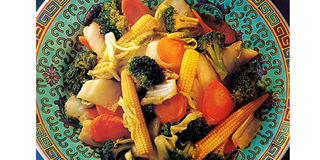Chinese vegetables their way

Chinese vegetables are a balance and blend of colour, texture and taste. PHOTOS | A KADUMUKASA KIRONDE II
What you need to know:
- Lao Tzu and Confucius were contemporaries, but while Confucius laid out principles of behaviour and manners, Taoism relied on intuitive behaviour, on a person seeking and hopefully finding an individual way
In China, the long-standing tradition of consuming only vegetables lies in the merging of its soybean and rice culture with its religion and philosophies. Since time immemorial, the choice of foods in China has been influenced by the religious beliefs and edicts that were inspired by Buddha and the behavioural philosophies of Lao Tzu and his Taoism of Confucius. Lao Tzu and Confucius were contemporaries, but while Confucius laid out principles of behaviour and manners, Taoism relied on intuitive behaviour, on a person seeking and hopefully finding an individual way. However, all of these belief systems were and are intrinsically connected with food.
Forbidden
To date and in general, Buddhist monks and nuns in China are forbidden to eat meat, poultry, fish, eggs or just about everything that at one time lived in the animal world. Curiously, they are allowed to eat oysters, clams and mussels-----ostensibly these are deemed to be vegetables of the sea---- to replace three strong flavoured proscribed vegetables viz leeks, chives and shallots.
Fanatical observant and ultra conservative Buddhists, either refrain only on specific days, such as the first 15days of the lunar year or the first and fifteenth day of each month. Strict Taoists can choose to eat or desist from meat, though the majority entirely refrain. Confucius wisely saw merit in vegetarianism due to its discipline and yet devoted treatises to the precise preparation of all foods, giving as much importance to meat as well as vegetables.
Presentation
Over the centuries, the presentation of vegetables – whether for observant Buddhists or not – became Chinese art, especially in Hangzhou, South of Shanghai. Restaurants vied to present edible beauty, tasty art, with large flat plates as the canvasses. No banquet would be complete without amazingly exquisite images of peacocks and roosters, dragons and phoenixes, butterflies and fans, “drawn” with threads and slices of bean curd and vegetables.
To be sure, there were a wide spectrum of vegetable preparation in China—stir fried, deep fried, braised, steamed, stewed and cooked in soup etc. Nevertheless, the artistic materials of vegetable cooking remain bean curd, or dofu (sic), which can be cut, sculpted, and moulded as well as to a lesser extent, wheat gluten. In the hands of Hangzhou’s accomplished chefs, fresh bean curd, cut in particular ways, seasoned with unique ingredients, became in a manner of speaking “chicken” and “pork”. Seasoned bean curd— cooked in soy sauce and spices and then dried and pressed –became “beef” for stir-frying with other vegetables. Mashed taro was transformed into “fish,” and gluten became “scallops.”
All of this culinary subterfuge started in the Buddhist temples with monks and nuns who sought substitutes for meat. Efforts to duplicate meat flavours were frequently made, but it was more important for the artistic creations to look like food that was forbidden with the intention being to deceive the eye while at the same time pleasing the palate! The artifice of this so called temple food became art.
Stir fried mixed vegetables
When selecting different items for a vegetable stir-fried dish, avoid mixing the vegetables ad hoc and indiscriminately. The aim is to achieve a harmonious balance and blend of colour, texture and taste. All the vegetables mentioned are locally available at Nakasero Market and supermarkets such as Carrefour.

Ingredients
Serves 4
• 250g/10oz Chinese leaves or pak choi will do and even spinach would suffice.
• 120g/4oz baby corn cobs
• 120g/4oz broccoli
• 6 tbsp pre-cooked fresh green peas
• 1 medium or 2 small carrots
• 60ml/4 tbsp vegetable oil
• Salt and pepper to taste
• 5ml/1 tsp brown sugar
• 1 medium onion thinly sliced into rings
• 1 knob crushed garlic
• 1 tbsp crushed ginger
• 2 green chilies finely chopped (optional)
•Vegetable stock or water if necessary
•15ml/1 tbsp light soy sauce or more as needed
•A few drops of sesame oil
Method
1. Wash and cut the vegetables into as much as possible similar shape and size and set aside
2. Heat the oil in a preheated wok and when hot add the garlic, onions and ginger and the green chili if you are using, stir fry for a couple of minutes until the onions become translucent.
3. Add the rest of the vegetables and the salt, sugar, soy sauce and sesame oil and continue stir frying until the vegetables become tender. If need be, you may add some vegetable stock or water as the vegetables are cooking. Make sure that everything is well blended and just before serving, taste and correct seasoning. Serve hot




